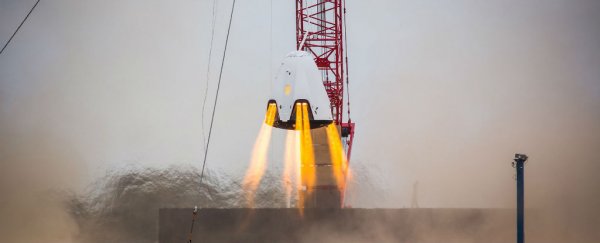SpaceX has just released footage of a successful 5-second hover test using its Dragon 2 space capsule at the company's rocket facility in Texas, and holy crap, that thing is mesmerising. But why is this such a big deal? Completing the hover test shows that SpaceX is well on its way to achieving propulsive landing, which means a manned version of the capsule wouldn't need to land using parachutes - it could land on solid ground using nothing but the power of thrust, and that's great news for our future manned missions to Mars.
The Dragon 2 capsule is an updated version of SpaceX's Dragon capsule, which has been ferrying cargo to the International Space Station (ISS) for a few years now. The private space company has just had its contract extended to 2020, but founder Elon Musk wants to do more than cart payloads in and out of orbit - he wants to make use of the contract SpaceX won from NASA back in 2014 to take astronauts to the ISS. And he wants to use a manned version of Dragon 2 to do it.
The hover test was actually performed in November, but SpaceX has been keeping a tight lid on the details until now. NASA describes Dragon 2's hovering ability as having the accuracy of a helicopter, which is exactly where it needs to be, and shows that the spacecraft could potentially land using the power of thrust instead of parachutes.
"On November 24, SpaceX's Dragon 2, powered by eight SuperDraco engines, executed a picture-perfect propulsive hover test at the company's rocket development facility in McGregor, Texas," the company announced over the weekend. "Eight SuperDraco thrusters, positioned around the perimeter of the vehicle in pairs called 'jet packs', fired up simultaneously to raise the Crew Dragon spacecraft for a 5-second hover, generating approximately 33,000 lbs (14,968 kg) of thrust before returning the vehicle to its resting position."
The test was the second of a two-part milestone under NASA's Commercial Crew Program, which requires a spacecraft to prove it can sustain a healthy propulsion system by firing its engines for a short period of time, and then demonstrate via a longer burn that the vehicle can be controlled while hovering.
While it might look fairly easy, achieving the controlled propulsive landing of a spacecraft is one of the hardest things you can do in the field, because, as Musk explained in 2014 when the Dragon 2 was still under construction, until very recently there simply wasn't the technology available to build the SuperDraco thrusters to do the job. That is, until 3D printing came along:
"One of the technologies that was really critical to the development of the SuperDraco engine was the ability to do 3D metal printing, because it is quite a complex engine and was very difficult to form all the cooling channels and the injector head and the throttling mechanism, but being able to print very high strength advanced alloys, I think was crucial to being able to create the SuperDraco engine as it is."
Initially, the first passengers in Dragon 2 will still be dropped back into the ocean under parachutes, but the company is aiming to have soft, solid-ground landings for NASA astronauts in the future.
To get an idea of just what an incredible feat this was to accomplish, watch Destin from Smarter Every Day try to hover a plain, old helicopter for the first time. Like he says, everything about it is "hilariously hard":
